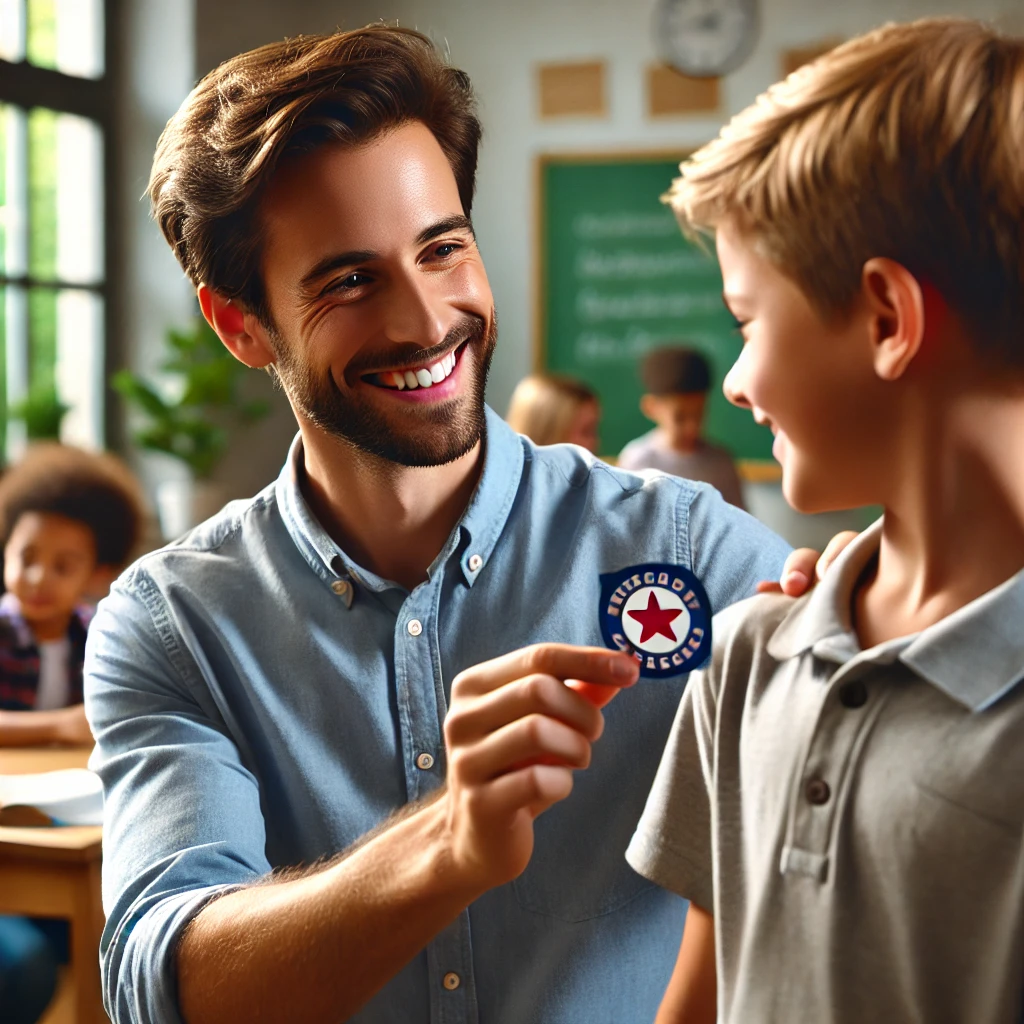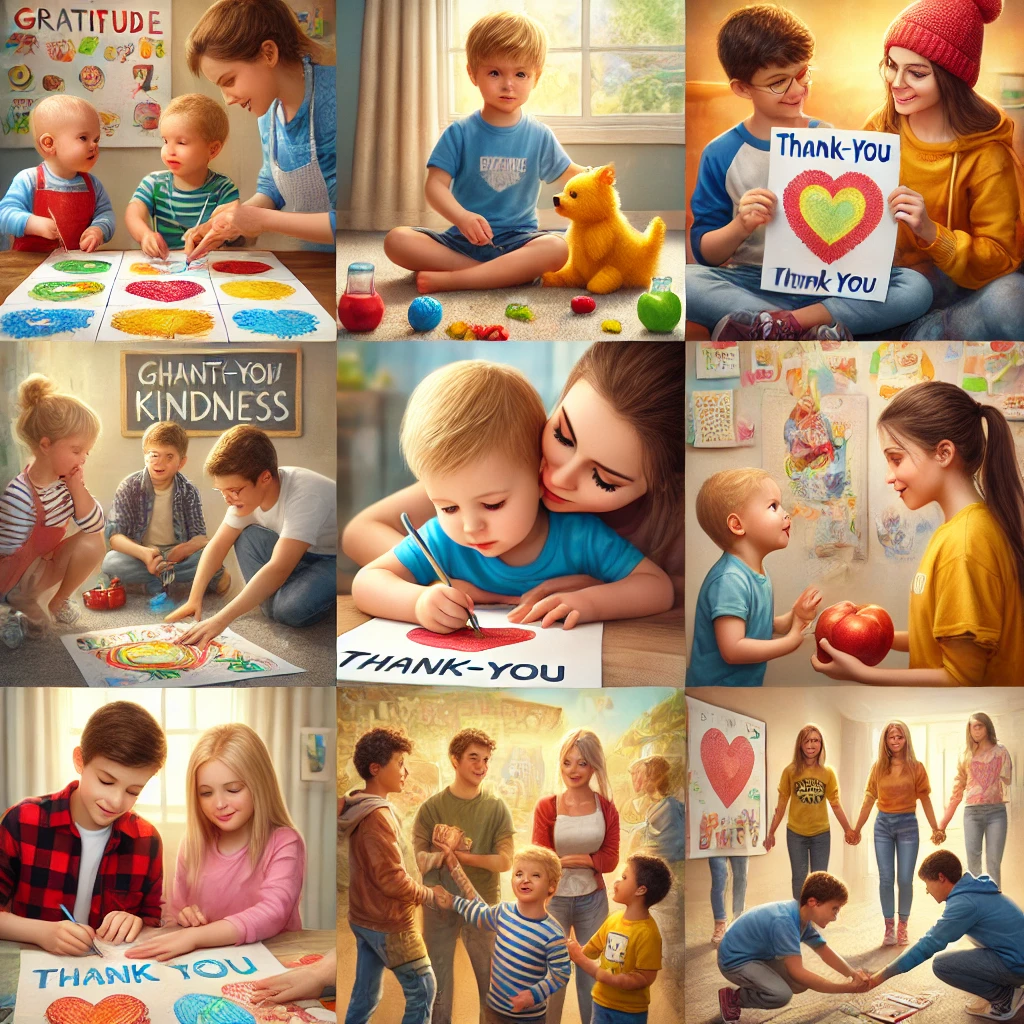1. Introduction
Gratitude and kindness are two fundamental virtues that significantly influence a child’s emotional well-being, social development, and overall sense of responsibility. From an early age, children absorb values from the people around them—particularly parents, caregivers, and educators.
Teaching gratitude and kindness nurtures empathy and good manners and is a powerful method of helping children develop resilience, self-esteem, and meaningful relationships.
Why Teaching Gratitude and Kindness Matter
Gratitude is the quality of being thankful, an appreciation for what one has or receives. Kindness, on the other hand, involves showing compassion, empathy, and generosity toward others. Both qualities are interconnected and mutually reinforcing. A sense of gratitude often fosters a willingness to share and help others, while acts of kindness can inspire a deeper appreciation of our blessings.
According to studies discussed on Verywell Mind, children who learn to regularly practice gratitude and kindness are more likely to exhibit stronger social skills, build healthy relationships, and demonstrate greater emotional regulation. These skills not only help children adapt to challenges and setbacks but also serve as building blocks for academic success and long-term well-being.
Early Cultivation of Positive Values
The benefits of teaching gratitude and kindness from an early age cannot be overstated. Early childhood is a formative stage when character is shaped, and habits—whether beneficial or harmful—begin to take root. By integrating gratitude and kindness into daily activities, children learn to perceive the world through a more empathetic and appreciative lens. This foundation helps them navigate life’s complexities with resilience, optimism, and the ability to extend support to those around them.
In the following sections, we will explore the definition of gratitude and kindness, discuss their complementary roles in personal development, examine the benefits of these virtues, and suggest practical strategies for parents, educators, and caregivers. By teaching gratitude and kindness, and then incorporating these practices into daily routines, families and communities can cultivate a generation of empathetic, compassionate, and thankful individuals.
2. Understanding Gratitude and Kindness

Defining Gratitude
Gratitude is a state of thankfulness, a recognition that life contains positive elements—even in challenging times. Children who understand gratitude learn to value people, experiences, and possessions. It is not limited to tangible gifts; it also encompasses appreciation for love, support, opportunities, and small everyday moments.
Gratitude can manifest in various forms:
- Verbal Expressions: Saying “thank you,” sending thank-you notes, or verbally acknowledging someone’s efforts.
- Nonverbal Acts: Smiling, hugging, offering help, or simply paying attention to the person you appreciate.
- Internal Reflection: Feeling an inner sense of happiness and contentment when recognizing something positive in one’s life.
Defining Kindness
Kindness is the act of being considerate, helpful, and benevolent toward others. It involves empathy—the ability to place oneself in another person’s situation—and a willingness to alleviate suffering or offer positive reinforcement. Kindness is often expressed through small yet impactful deeds, such as helping a sibling with homework, sharing toys, or comforting a friend who is upset.
How Gratitude and Kindness Complement Each Other
Although they are distinct virtues, gratitude, and kindness reinforce each other:
- Empathetic Connection: A child who feels grateful for the kindness received from others is more likely to reciprocate that kindness, fostering an environment of mutual respect.
- Positive Mindset: Gratitude encourages a positive outlook on life, while kindness creates positive experiences for both the giver and the receiver.
- Cycle of Good Deeds: When children express kindness, they often receive appreciation and gratitude in return, creating an ongoing cycle of emotional warmth and interpersonal harmony.
These virtues serve as crucial building blocks for personal development, helping children cultivate qualities like empathy, respect, and generosity. In turn, these traits shape their relationships with family members, peers, educators, and society at large.
3. Benefits of Teaching Gratitude and Kindness

3.1 Emotional and Psychological Advantages
- Improved Self-Esteem: Children who consistently feel and express gratitude tend to have better self-esteem because they learn to appreciate their abilities and the support they receive.
- Enhanced Empathy: Teaching kindness fosters empathy—understanding and sharing the feelings of others. Empathy is essential for nurturing compassion, cooperation, and healthy social interaction.
- Reduced Stress and Anxiety: According to Verywell Mind, gratitude practices have been linked to lower levels of stress and anxiety. When children focus on the positive aspects of their lives, they are less likely to be overwhelmed by negative events.
3.2 Impact on Social Relationships and Academic Performance
- Stronger Social Bonds: Children who exhibit gratitude and kindness tend to form deeper and more enduring friendships. A child who recognizes and appreciates others’ contributions is more likely to be supportive and understanding.
- Positive Classroom Environment: In educational settings, kindness leads to cooperation, respect for classmates, and fewer behavioral issues. This, in turn, results in a more positive classroom atmosphere that facilitates better learning outcomes.
- Improved Academic Engagement: Research cited by PositivePsychology.com suggests that grateful children show higher levels of school satisfaction and engagement. Acts of kindness may also improve peer relationships, creating a supportive learning environment in which academic achievement can flourish.
3.3 Long-Term Effects on Overall Well-Being
- Resilience and Optimism: Instilling gratitude in children helps them develop resilience by focusing on what they have rather than what they lack. Similarly, kindness promotes a sense of purpose and fulfillment that can help them face life’s challenges.
- Healthy Relationships into Adulthood: When children grow up practicing gratitude and kindness, they become adults who value connection, empathy, and respect. This creates a ripple effect on their future families, workplaces, and communities.
- Improved Mental Health: Longitudinal studies show that people who practice gratitude have lower rates of depression and feel more satisfied with life. Verywell Mind and other sources argue that these benefits can begin in childhood, setting the stage for a healthier emotional life.
4. Strategies for Teaching Gratitude

4.1 Modeling Behavior
Children are observant and often mimic the actions and attitudes of the adults around them. If parents and educators demonstrate gratitude in their daily interactions—thanking a waiter at a restaurant, expressing appreciation for a kind gesture, or maintaining a gratitude journal—children quickly learn that gratitude is a normal and valued part of life.
- Express Thankfulness Openly: When you feel thankful, say so. For instance, “I’m grateful to you for helping me with the dishes—it made my evening much easier.”
- Share Personal Stories: Talk about moments during your day when you felt especially grateful. This can be a powerful way to emphasize how gratitude enhances overall well-being.
4.2 Gratitude Journals
Encourage children to record one to three things they are grateful for each day in a dedicated journal. This helps them focus on the positives in life, teaching them to identify and value supportive friendships, family moments, and personal achievements.
- Make It a Daily Habit: Set aside a few minutes each evening or morning to write or draw what they feel thankful for.
- Offer Guidance: For younger children, it might help to give prompts like: “What made you smile today?” or “Who helped you today?”
- Encourage Creativity: Children can draw pictures, use stickers, or write short sentences. The more engaging the activity, the more likely they will stick to it.
Example: “Introduce your child to gratitude journaling with this fun gratitude journal for kids”
4.3 Thank-You Notes
Teaching children to write thank-you notes is an excellent way of reinforcing the concept of expressing appreciation:
- Practical Exercises: After receiving gifts or acts of kindness (for instance, from grandparents, friends, or teachers), guide children in writing or drawing a simple thank-you message.
- Emphasize Sincerity: Encourage them to use genuine, heartfelt language. Instead of generic phrases like “Thanks for the present,” they might say, “Thank you for the colorful puzzle. I love putting it together with my family.”
- Discuss the Importance of Thoughtfulness: Help them understand why acknowledging someone’s gesture matters—both to the recipient and to themselves.
4.4 Gratitude Rituals
Regular family or classroom routines can incorporate gratitude:
- Family Dinners: Invite each person to share one thing they’re grateful for before or during the meal. This simple habit creates an atmosphere of appreciation and open communication.
- Weekly Meetings: Have a short session each week in which every family member or student shares what they learned or appreciated during the week.
- Morning Affirmations: Encourage children to start the day with a positive thought or statement of gratitude, setting a constructive tone for the day.
4.5 Storytelling
Stories are a powerful medium to convey moral lessons and values (Blissful Kids). Selecting books, fables, or even short videos that highlight gratitude can leave a lasting impression on children:
- Choose Age-Appropriate Themes: Younger children might enjoy illustrated storybooks featuring grateful characters, while older children could benefit from biographies of individuals who overcame hardships through gratitude.
- Engage in Discussions: After reading or watching, ask open-ended questions like, “How did the character show gratitude?” and “Why do you think that was important?”
- Incorporate Role-Play: Invite children to act out scenes from gratitude-themed stories, reinforcing the lessons through experiential learning.
5. Strategies for Teaching Kindness

5.1 Random Acts of Kindness
Encouraging children to perform spontaneous acts of kindness instills in them the habit of looking for opportunities to help and uplift others:
- Small Gestures: Holding the door for someone, sharing snacks, or offering a smile to a friend who seems sad.
- Community Focus: Encourage them to do small kindnesses for neighbors or within their school community, such as picking up litter or helping classmates.
- Reflection: After a kind act, discuss how it made both the giver and receiver feel. This reflection reinforces the emotional rewards of kindness.
5.2 Volunteering
Volunteering provides children with real-world experiences that help them understand the challenges others face and how they can make a difference:
- Family Involvement: Participate in community clean-ups, food drives, or charitable events as a family. Children learn that giving time and effort can have a tangible impact on people’s lives.
- School Initiatives: Encourage involvement in school-based programs where students can mentor younger children, assist classmates with reading, or support recycling efforts.
- Discuss the Experience: After volunteering, talk about what was learned, emphasizing empathy, teamwork, and community spirit.
Example: “Empower Your Child to make a Difference with Kindness is my Superpower book”
5.3 Role-Playing
Role-playing offers a safe environment for children to practice kindness and empathy in hypothetical scenarios:
- Conflict Resolution: Present a situation where two children are arguing, and have your child act out how to resolve it kindly.
- Helping Scenarios: Create situations where someone needs help (e.g., carrying something heavy, or being left out of a group). Prompt children to consider the best ways to offer assistance.
- Building Confidence: Role-playing helps children develop the confidence to act kindly in real-life situations because they have already rehearsed the behavior.
5.4 Kindness Challenges
Set goals for daily or weekly acts of kindness, turning kindness into a friendly competition or collaborative game:
- Kindness Calendar: Create a calendar listing small tasks such as “Compliment a classmate” or “Write a thank-you note to a teacher.” Check off each completed act.
- Group Goals: In a classroom or family context, set a collective goal, such as completing 50 acts of kindness in a month. Celebrate the achievement collectively, reinforcing the value of teamwork.
- Track Progress: Use stickers or stars to mark each act of kindness. Visual tracking can motivate children to continue their efforts.
5.5 Positive Reinforcement
Recognizing and rewarding kind behavior encourages children to repeat those actions:
- Verbal Praise: Simply saying, “I’m proud of how kind you were today” or “That was a caring gesture” validates the child’s efforts.
- Small Tokens: Stickers, badges, or a certificate of appreciation can work as tangible acknowledgments.
- Highlight Impact: Rather than focusing solely on the reward, emphasize how their kindness made a difference to someone else.
6. Integrating Gratitude and Kindness in Daily Life

6.1 Family Activities
Engage in activities that merge both gratitude and kindness:
- Cook Together: While preparing a meal, discuss the people involved in providing the ingredients—from farmers to truck drivers. This brings gratitude to the forefront. Then share the meal with a neighbor or friend, demonstrating kindness.
- Art Projects: Create collaborative art projects that revolve around themes of gratitude and kindness—paint a “thankful tree” or craft a “kindness board.”
- Outdoor Adventures: While on a family walk or picnic, encourage children to pick up trash and express thanks for nature’s beauty.
Example: “Encourage kindness through play with this top-rated emotional intelligence board game.”
6.2 Educational Settings
Teachers and school administrators play a crucial role in nurturing these virtues:
- Curriculum Integration: Assign reading materials or group projects focused on compassion, empathy, and gratitude.
- Positive Environment: Display posters or bulletin boards where students can publicly share what they are grateful for or the kind acts they have witnessed.
- Recognize Milestones: Acknowledge students who consistently show gratitude and kindness, reinforcing the idea that these virtues are integral to academic success.
Example: “Create a fun family gratitude tradition with this cute gratitude jar set.”
6.3 Digital Tools
While technology can be a source of distraction, it can also be harnessed for positive growth:
- Gratitude Apps: Several apps, such as digital gratitude journals, remind children to note down what they are thankful for each day.
- Kindness Trackers: Some platforms allow students and families to record acts of kindness, turning virtuous acts into an engaging online activity.
- Safe Social Media Use: Encourage older children to spread positivity online by leaving kind comments, sharing uplifting stories, and recognizing friends’ accomplishments.
7. Challenges and Solutions

7.1 Addressing Entitlement
In a culture where material possessions are often emphasized, children may develop a sense of entitlement, believing they deserve all they desire without effort or appreciation.
- Emphasize Effort and Responsibility: Remind children that privileges come with responsibilities. Encourage them to earn rewards through chores, good behavior, or academic effort.
- Limited Access to Luxuries: Set boundaries on screen time, desserts, or toys. Teach children the difference between “wants” and “needs,” and encourage them to be grateful for what they do have.
- Involve Them in Giving: Encourage children to donate outgrown clothes or unused toys, helping them see that they can make a difference in someone else’s life.
7.2 Consistency
It can be difficult to maintain a regular practice of gratitude and kindness without it becoming monotonous:
- Variety in Activities: Rotate different strategies—journaling, thank-you notes, and storytelling—so that children remain engaged.
- Flexible Scheduling: While consistency is key, avoid turning these practices into forced routines. Give children some autonomy in deciding when and how to practice gratitude and kindness.
- Celebrate Progress: Periodically reflect on how these practices have benefited the family or classroom environment. Genuine acknowledgment can rekindle motivation.
7.3 Age-Appropriate Methods
Children of different developmental stages have varying capacities for understanding and practicing gratitude and kindness:
- Toddlers (Ages 2–4):
- Use simple phrases like “Thank you” or “That was kind.”
- Engage in quick, visual activities such as drawing pictures of things they appreciate.
- Young Children (Ages 5–7):
- Introduce gratitude journals with short sentences or drawings.
- Practice role-playing kindness scenarios playfully.
- Preteens (Ages 8–12):
- Encourage more detailed gratitude entries and thoughtful thank-you notes.
- Assign small community service tasks, like helping neighbors or volunteering at school events.
- Teenagers (Ages 13+):
- Introduce reflective writing on gratitude, exploring deeper questions like “What lessons can you learn from challenges?”
- Encourage mentorship roles and leadership in kindness initiatives at school or in the community.
By tailoring strategies to each developmental stage, children remain enthusiastic and engaged, and the lessons become more meaningful and impactful.
8. Conclusion

Gratitude and kindness are powerful virtues that shape a child’s emotional, social, and intellectual growth. From improving self-esteem and empathy to fostering resilience and strong community ties, these values serve as the foundation for a well-rounded and fulfilling life. By incorporating strategies such as modeling gratitude, maintaining gratitude journals, writing thank-you notes, encouraging random acts of kindness, and using role-play scenarios, parents and educators can effectively instill these qualities in children.
Though challenges like entitlement and consistency may arise, they can be addressed through a variety of fun, age-appropriate activities. By integrating gratitude and kindness into daily routines, both at home and in educational settings, adults help children cultivate positive behaviors and mindsets that will benefit them—and those around them—throughout their lives.
We invite you to implement these techniques and observe the transformation in your children’s attitudes, relationships, and overall well-being. Share your experiences, insights, and suggestions on fostering gratitude and kindness with your community, and join in the collective effort to raise a generation of compassionate, empathetic, and grateful individuals.




